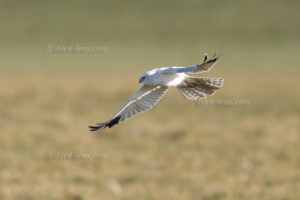 At least since Sonday, March, 29, 2020, the Niedere Flaeming, a hilly contryside south of Berlin, is home to a male Pallid Harrier (Circus macrourus). The Niedere Flaeming near Jueterbog is roughly 60km distant from downtown Berlin.
At least since Sonday, March, 29, 2020, the Niedere Flaeming, a hilly contryside south of Berlin, is home to a male Pallid Harrier (Circus macrourus). The Niedere Flaeming near Jueterbog is roughly 60km distant from downtown Berlin.
This adult male Pallid Harrier braved the onset of winter in the Lower Fläming very well. With measured 2 ° C, snow showers and a strong eastern wind, the bird was sitting in the winter cereals. By luck the Harrier was spotted between the green stalks of straw with its strikingly white head. When we arrived, the first observer’s car was thankfully still at the point of observation. A little later, when the bird watcher got up in his car to warm up, I just unpacked the tripod and set up the heavy Canon EF 600mm f / 4L IS III USM lens on the Canon EOS 1DX Mark III. Shortly after the bright bird rose from the green and flew elegantly deep over the winter grain field. It dropped twice between the stalks. When the male Pallid Harrier flew up again, an interesting grey pattern could be seen on the tail. The Pallid Harrier could be persued with the camera in full shooting. After about 3-4 minutes the bird had reached the end of the field and disappeared over a windbreak hedge.
I was glad to have already made some presets on my new Canon EOS 1DX Mark III. For this I had set up AI Servo, the AF point selection in a zone and Case 1 with exposure times from initially 1/320 sec. to 1/1000 sec. Although the flying bird had to be photographed against a structured background, the autofocus only rarely lost the bird and could then “catch” it again and again. The number of images fort he trash were very small. The autofocus tracking seems to work much better with the 1DX Mark III than with its predecessors.
This Pallid Harrier male had very pale grey upperparts and is white below. In flight, the distinctive black wing tips and the dark patternd tail can be seen very well. Young male Pallid Harrier look not so bright white, in the earliest stages, they have coloration similar to the female. This individual seemed very light, almost white. Therefore the ornithologists unanimously call the bird an adult male.
After all there were only a few birders on site the last few days. I was able to observe the male Pallid Harrier some days later in the early hours of a beautiful but crispy morning again. Looking from a hide, the Pallid Harrier could be seen in the first light – again it was sitting in the winter cereals. I waited 1 and a half hours in a hide. But the bird was only sitting and preening. At 8:30 AM the Pallid Harrier started swiftly and disappeared over the ridge. After a while I packed my thinks, enjoyed the early sunbeams and made my way. Following with little hope the direction the bird have flown, the male Pallid Harrier could be rediscovered the grass near the small stream Nuthe. The Pallid Harrier was sitting there, but was airborne again after some minutes.
The peculiar proportions of the Harrier was clearly visible: the Pallid Harrier hat a small, slim-winged, slim-bodied appearance with an effortless flight.
In order to meet the growing demand for top images of the rarer species of Palaearctic Bird-lens.com has specifically made trips to remote places. Additionally every chance is used, if a rare bird is around the homeground. This to do everything to ensure excellent photos of the Birds of the Western Palearctic . The yield of pictures also of rare Western Palaearctic birds is very good. The picture of the blog is just an image of proof. But there are nice images of birds, that what you will find behind the tab “Picture- Shop“. Just give a notice if you need a picture of a bird which is not online.